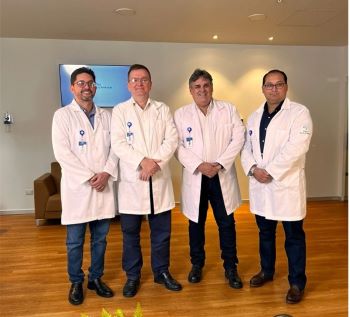First FLS In Bolivia Joins The Capture The Fracture Programme

In the picture, from left to right, we welcome the FLS team composed of Dr. Rodrigo Roca, orthopaedic and trauma specialist; Dr. Bozorg Zonneveld, internal medicine and emergency physician; Dr. Felipe Melgar, geriatric specialist; and, Dr. Gabriel Cuellar, neurosurgeon.
The Clínica Metropolitana de las Américas has become the first health facility in Bolivia to join the Capture The Fracture® (CTF) program for secondary fracture prevention. This achievement marks a milestone in bone health care in the country and promises to change the landscape of osteoporotic fracture prevention. Bolivia is the 55th country represented on the Map of Best Practice, which now includes a network of 879 FLS worldwide.
We had the opportunity to speak with Dr. Rodrigo Roca López, a leading member of the clinic's FLS team. Dr. Roca López is a specialist in Orthopedics and Traumatology with a postgraduate degree in Shoulder and Elbow Surgery, and was the driving force behind this important addition to the CTF network. During a refresher course in osteoporosis, Dr. Roca López learned about the Capture the Fracture® program and proposed the creation of the FLS service to the Clinic's executives, with the purpose of carrying out all the necessary practices for the secondary prevention of fractures.
IOF: What motivated you to join the Capture the Fracture® network?
Dr. R.L.: At Clínica Metropolitana de las Américas, we strongly believe in the importance of secondary prevention of osteoporotic fractures. Osteoporotic fractures are a serious condition that can have a significant impact on patients' quality of life. Secondary prevention of fractures can help reduce the risk of future fractures and improve the health and well-being of patients. To carry out this mission, we have assembled a multidisciplinary team that includes specialists in Geriatrics, Internal Medicine, Neurosurgery and Orthopedics and Traumatology.
IOF: In what ways do you expect Capture The Fracture® to contribute to your FLS?
Dr. R.L.: I hope that Capture the Fracture® will contribute to my FLS in several ways. First, we are confident that the program will help us improve the quality of services we provide to our patients. Capture the Fracture® provides resources and tools that will help us provide more comprehensive and coordinated care to our patients. Second, I hope that Capture the Fracture® will make it easier for us to connect with other FLSs around the world. Sharing experiences and knowledge with other healthcare professionals will help us improve our own skills and knowledge. Finally, we hope that Capture the Fracture® will contribute to increasing public awareness of osteoporosis and fracture prevention. The more the public knows about osteoporosis, the more likely they are to take action to prevent future fractures.
IOF: In your own words, how would you describe the situation of post-fracture care and FLS in Bolivia?
Dr. R.L.: Currently, there is not a strong culture of post-fracture care in Bolivia. Medical care has focused mainly on treating the problem of the fracture itself, with less focus on preventing future fractures. In many cases, there is even no specific treatment for osteoporosis after a fracture.
That is why the FLS at the Clínica Metropolitana de las Américas marks a crucial milestone in bone health care in Bolivia. We hope that by raising awareness of the Capture the Fracture® programme, we can motivate the creation of other FLSs in Bolivia and change the perception of the importance of secondary fracture prevention in the country.
We thank Dr. Rodrigo Garcia Roca and the entire team at the Clínica Metropolitana de las Américas for their commitment and valuable contribution to promoting bone health in the region. Welcome to the Capture the Fracture® Map of Best Practice! If your hospital or clinic has an FLS that has not yet joined the Capture the Fracture® Network, click here to learn more.